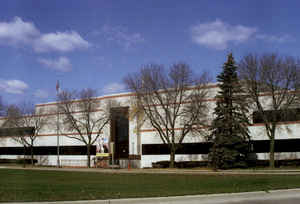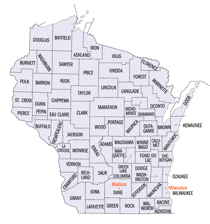Wisconsin Counties
There are seventy-two counties in the state of Wisconsin. Wisconsin became part of the Territory of Michigan and divided into two counties: Brown County in the northeast along Lake Michigan and Crawford County in the southwest along the Mississippi River. The state of Wisconsin was created from Wisconsin Territory on May 29, 1848, with 28 counties.Marathon County, Wisconsin
Marathon County Education, Geography, and History

Marathon County is a county located in the state of Wisconsin. Based on the 2010 census, the population was 134,063. Its county seat is
Wausau. It was founded in 1850, created from a portion of Portage County. At that time the county stretched to the northern border with the
upper Michigan peninsula. It is named after the battlefield at Marathon, Greece.
Marathon County comprises the Wausau, WI Metropolitan Statistical Area and is included in the Wausau-Stevens Point-Wisconsin Rapids, WI
Combined Statistical Area.
Etymology - Origin of Marathon County Name
Was named from the famous Greek battlefield.
[Source: Gannett, Place Names, p. 171 Card file at the WHS library reference desk.]
Demographics:
County QuickFacts: CensusBureau Quick Facts
Marathon County History
Located in north central Wisconsin, Marathon County is a beautiful, fertile area of rolling plains and hills. In
1850 when Marathon County was organized by action of the state legislature, its land was heavily forested, and most
of the 500 inhabitants made their living from the rich timber resources. This early dependence on forest wealth is
still reflected in many county industries, but the healthy economy of today is characterized by industrial
diversification and the utilization of all natural resources.
Area: 1,584 square miles - the largest of Wisconsin's 72 counties.
Marathon County was officially established in 1850 and Wausau was selected as the county seat. From a Chippewa name
meaning `Far Away' - has grown to a vigorous city of 38,426 people.
Marathon County is the number one ranking dairy producing county in the State.
Most of the county's industry is centered in the urban areas. Lumber was the original industry and wood and paper
products have remained the leading industries. However, there is a wide variety of industrial plants which
manufacture more than 50 different products.
Some of the most important products manufactured in Marathon County are paper and food packages, lumber and building
materials, dairy products, electric motors, boxes, road building and industrial machinery, veneers and red granite
monuments and materials.
Marathon County is the leading county in the nation for ginseng production.
Forestry facts of Marathon County are an indication of the important role the lumber and paper industry has played
in the development of this area.
Three paper mills are located in the county, their expertise being specialty and high quality writing and printing
paper. There are also a number of sawmills throughout the county.
One-third of the county land area is forest land. Most woodland is in 30 or 40 acre tracts attached to individual
farms. Many farmers use income from the woodlots to help pay their taxes each year.
In Marathon County, the Rietbrock Geographical Marker locates the exact center of the northern half of the Western
Hemisphere. It is here that the 90th Meridian of Longitude bisects the 45th Parallel of Latitude, meaning it is
exactly halfway between the North Pole and the Equator, and is a quarter of the way around the earth from Greenwich,
England.
John W. Hunt's 1853 Wisconsin Gazetteer
"MARATHON, County, is bounded on the north and northeast by the State line, east by Waupaca and Oconto, south by Portage, and on the west by Chippewa and La Pointe. It was established from Portage, and fully organized February 9, 1850. Wausan, at Big Bull Falls on the Wisconsin river, about 20 miles north from the south line of the county, is the seat of justice. It is celebrated for its extensive regions of pine timber, and the production of pine lumber, rather than for agricultural pursuits. The mills in Adams, Portage, and Marathon, cut nearly sixty millions feet per annum. "
MARATHON
From: Handbook of Wisconsin by S. Silas, 1855
pg. 81-83
Extends from between towns 26 and 27 north to Michigan, 128 miles in its longest part, and is 42 miles wide. The
southern part only is surveyed, though the surveyors are now pushing towards the north. Its principal business is in
lumber, and it sends a large amount down the Wisconsin. The soil is not generally good for agriculture, though good
farms can be selected. The greater portion of the land is in the hand of Government.
Wausau is the County Seat, and a flourishing place.
Little Bull Falls, about eight miles below Wausau, is also a prosperous lumbering place, and has in its vicinity
some of the best farming lands in that region. All the County is in the Steven's Point land district.
The surveyors, now employed in towns 33 and 34 N. and ranges 5, 6, 7 and 8 E., report a very rugged country, with
but a moderate quantity of pine, prevailing timber being birch, hemlock, maple, elm, tamarack, &c. The County is
well watered with clear running streams, many small lakes, and occasional beautiful ridges of farming lands. As to
the pine lands, on the upper part of the Wisconsin River, a heavy district of the best kind, as yet but little
explored, lies on the Eagle branch in towns 37 and 38 N., ranges 8 and 9 E., as yet unsurveyed. This will soon be
surveyed and brought into market. It lies on the road from Wausau to Lake Superior, and a settlement there will form
a resting place between the two.
From Steven's Point to Virgini Falls, 45 miles, is a good wagon road--from that to Lake Agogebec, 87 miles, is only
a trail--from the Lake to Ontonagon, 30 miles, there is also a good wagon road;--making the whole distance from
Steven's Point to Ontonagon 132 miles. Efforts are making to have this established as a mail route. It is travelled
frequently every year by drovers with herds of cattle. The country from Wausau to Boileaux Rapids is a timbered
region, mostly composed of pine and hemlock, with an occasional hard wood ridge of maple, butternut, ash, &c., and
the soil good.
The Boileaux Rapids, or Grandfather Bull Falls, is a magnificent series of falls and rapids for about four miles,
with bold, rocky banks. The river is quite narrow, and navigation with rafts is rendered impossible by large numbers
of immense boulders the whole length of the fall. The whole fall is about 75 feet. This may, therefore, fairly be
called the head of navigation of the Wisconsin.
Geography: Land and Water
As reported by the Census Bureau, the county has a total area of 1,576 square miles (4,082 km2), of which, 1,545 square miles (4,001 km2) of it is land and 31 square miles (81 km2) of it (1.98%) is water.
Neighboring Counties
Bordering counties are as follows:
- Lincoln County - north
- Langlade County - northeast
- Shawano County - east
- Waupaca County - southeast
- Portage County - south
- Wood County - south
- Clark County - west
- Taylor County - northwest
Education







